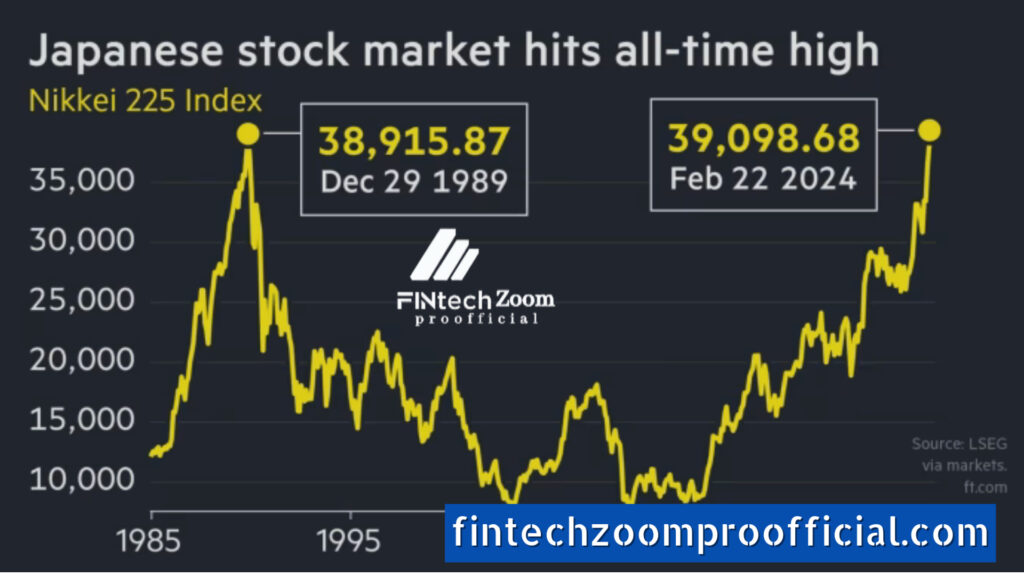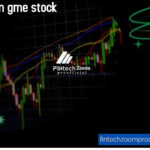
Table of Contents
Introduction: Understanding the Importance of the Fintechzoom.com Nikkei 225
The Nikkei 225 has long helped as a test of Japan’s economic health on behalf of the top 225 companies registered on the Tokyo Stock Exchange. As global markets become gradually organized, the Nikkei 225’s role extends past domestic borders, touching investment plans worldwide. In this article, we will explore Fintechzoom.com Nikkei 225 and compare it to other major Asian indices, such as Hang Seng and Kospi, providing insights into how these indices will perform in 2024. This analysis will study the old presentation, market instability, and the unique economic factors formative each index.
Fintechzoom.com Nikkei 225 Overview and Its Global Impact
Historical Performance of the Fintechzoom.com Nikkei 225
The Fintechzoom.com Nikkei 225 has been a vital pointer of Japan’s economic growth since its start in 1950. Factually, the index has followed Japan’s business development, sparkly the strength of sectors such as automotive, electronics, and finance. For example, after Japan’s post-war economic wonder, the Nikkei 225 saw first-time growth, topping at over 38,000 points in 1989. However, the economic boil burst led to a sharp weakening, from which the Nikkei has yet to recover fully. However, the index has shown flexibility in recent years, especially during global troubles like the COVID-19 sickness.
- Bullet Points:
- The Nikkei 225’s peak in 1989 at 38,915 points.
- Recovery post-sickness and its rise towards 30,000 points by 2023.
- Key sectors: automotive, electronics, and medicines.
The Role of the Fintechzoom.com Nikkei 225 in Japan’s Economy
The Nikkei 225 reflects Japan’s export-driven economy, with many companies deeply dependent on international trade. As of 2024, companies like Toyota, Sony, and Mitsubishi control the index, each playing a serious role in Japan’s global track. Today, the Fintechzoom.com Nikkei 225 shows signs of a gift due to Japan’s upward focus on renewable energy, automation, and artificial intelligence.
Economic challenges such as ageing people and domestic decrease remain worries. Despite these issues, international investors look well upon the Nikkei 225 due to Japan’s stable economy and business power improvements, making it a rather secure market for long-term investments.
Fintechzoom.com Nikkei 225 vs Other Asian Indices: Key Comparisons for 2024
Nikkei 225 vs Hang Seng: Diverging Economic Narratives
The Hang Seng Index (HSI), representing Hong Kong’s largest companies, offers a different story linked to the Fintechzoom.com Nikkei 225. While Japan’s industrial and technological sectors drive the Nikkei 225, the Hang Seng is heavily influenced by China’s economic policies and financial services.
- Subsection Bullet Points:
- The Hang Seng’s heavy contact with real land and banking.
- The impact of China’s “Zero COVID” policy on the Hang Seng.
- Japan’s technological origination concerns Hong Kong’s focus on financial services.
In 2024, geopolitical tensions, mostly involving China, could suggestively impact the Hang Seng. In contrast, the Nikkei 225 is likely to maintain more steadiness due to Japan’s less unstable political situation. Fintechzoom.com Nikkei 225 today shows give in this area, making it a safer bet for investors wary of political volatility.

Nikkei 225 vs Kospi: Stability Amid Global Volatility
The Kospi, South Korea’s primary stock index, is often related to the Nikkei 225 due to both countries’ trust in exports. However, Kospi has shown greater suppleness during global declines, mostly due to South Korea’s varied economy, which contains high-tech exports and customer goods.
- Key Comparison Points:
- Kospi’s heavy focus on tech companies like Samsung and LG.
- The permanency of the Nikkei 225’s business sectors vs. Kospi’s instability.
- The Kospi’s quicker recovery post-2020 is related to the Nikkei 225.
While the Nikkei 225 has a more varied portfolio of trades, the Kospi’s tech-heavy focus can lead to higher volatility during tech industry fluxes. For investors looking for stability in 2024, the Nikkei 225 offers a safer alternative, mostly for long-term investments.
Economic Factors Influencing Fintechzoom.com Nikkei 225 in 2024
The Global Economy’s Impact on the Nikkei 225
2024, the global economic site will likely directly impact Fintechzoom.com Nikkei 225. Japan’s trust in exports, chiefly to the United States and China, means that troubles in these regions’ economies could affect the index. The U.S.-China trade tensions, for instance, have factually led to fluxes in the Nikkei 225.
Domestic Policies Supporting Growth in Japan
Japan’s government has announced several policies to boost the economy and, by leeway, the Nikkei 225. Business power reforms, motivations for technological innovation, and creative solutions to address the ageing population are all likely to contribute to the index’s growth in 2024.
- The push towards renewable energy sources and automation.
- Japan focuses on continuing global trade partnerships, mostly with Southeast Asian nations.
- Impact of reduced corporate tax rates and support for small and medium-sized creativities (SMEs) in Japan.
Case Study: Supply Chain Disruptions and Their Impact on the Nikkei 225
One of the most important events that struck the Nikkei 225 was the stock chain emergency 2022, tainted by global sickness. Companies within the index, especially those in the motorized and electronics sectors, faced production delays and improved costs, leading to short-term instability.
Case Study Data Points:
- Toyota, one of the largest suppliers to the Nikkei 225, saw its stock value drop by 10% during the height of the crisis.
- Recovery labours, driven by Japan’s strategic shift to localize production and reduce dependence on international supply chains, helped the Nikkei 225 regain permanency by late 2023.
This case highlights how external global factors can impact the Nikkei 225 and establishes the index’s skill to recover from short-term troubles.
Also Read: FintechZoom Best Stocks to Invest in: Starter Stocks for New Investors 2024
Conclusion: Fintechzoom.com Nikkei 225’s Resilience in 2024
In conclusion, Fintechzoom.com Nikkei 225 remains the global stock market, a key player for the company. Its past, varied industry picture, and Japan’s strategic economic rules position it positively related to other Asian films like Hang Seng and Kospi. Investors looking for a stable, long-term investment are looking for this. In 2024, the Nikkei 225 offers a convincing opportunity, particularly when viewed through global economic trends and national reforms.
References
- Bloomberg. (2023). Nikkei 225 Performance Overview: Market Insights.
- Financial Times. (2023). Global Stock Market Comparisons: Nikkei, Hang Seng, and Kospi.
- Reuters. (2024). Japan’s Economic Outlook: Policies and Reforms Impacting Nikkei 225.
- The Japan Times. (2023). Nikkei 225 Today: Trends and Forecasts.
- World Economic Forum. (2023). Supply Chain Disruptions: Lessons from 2022 for the Nikkei 225.

FAQs: Fintechzoom.com Nikkei 225 vs Other Asian Indices: A Comparative Outlook for 2024
What is Nikkei 225 used for?
The Nikkei 225 is used as a standard for the Tokyo Stock Exchange on behalf of Japan’s top 225 blue-chip companies. It reflects the overall presentation of the Japanese stock market and is often used by investors to assess Japan’s financial health.
Who owns Nikkei 225?
The Nikkei 225 is owned and succeeded by Nikkei Inc., an important financial media company in Japan. Nikkei Inc. is answerable for calculating and keeping the index.
What is the Nikkei 225 prediction for 2024?
Predictions for the Nikkei 225 in 2024 suggest continued constancy and growth, driven by Japan’s economic improvements and increased focus on technology and renewable energy. However, external factors like global market fluxes and geopolitical tensions may affect performance.
What is the Japanese Nikkei 225 Index?
The Nikkei 225 Index is Japan’s most standard stock market index. It tracks the performance of the largest 225 companies. openly traded companies on the Tokyo Stock Exchange across businesses like technology, automotive, and finance.
How does the Nikkei 225 compare to other Asian indices like the Hang Seng or Kospi?
The Nikkei 225 focuses on Japan’s industrial, technological, and export-driven sectors, while the Hang Seng reflects Hong Kong’s finance and real estate sectors. The Kospi highlights South Korea’s tech-heavy companies. Each index offers different investment opportunities depending on economic conditions and risk tolerance.
What factors affect the performance of the Nikkei 225?
Japan’s economic policies, global trade relations, business performance, and geopolitical factors make the Nikkei 225 unfair. Events like supply chain difficulties or changes in export requests can have an important impact on the index.
Can international investors invest in the Nikkei 225?
Yes, international investors can invest in the Nikkei 225 through exchange-traded funds (ETFs) or Japanese ADRs (American Deposit Receipts). These investment vehicles make it easier for global investors to access the Japanese stock market.
What sectors are most represented in the Nikkei 225?
The Nikkei 225 is deeply subjective towards electronics, automotive, and finance businesses. Toyota, Sony, and Mitsubishi are critical in the index’s performance.
FOR MORE EXCITING BLOGS PLEASE VISIT TEH WEBSITE: fintechzoomproofficial.com






